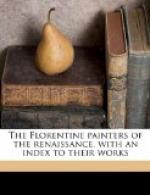Psychology has ascertained that sight alone gives us no accurate sense of the third dimension. In our infancy, long before we are conscious of the process, the sense of touch, helped on by muscular sensations of movement, teaches us to appreciate depth, the third dimension, both in objects and in space.
In the same unconscious years we learn to make of touch, of the third dimension, the test of reality. The child is still dimly aware of the intimate connection between touch and the third dimension. He cannot persuade himself of the unreality of Looking-Glass Land until he has touched the back of the mirror. Later, we entirely forget the connection, although it remains true, that every time our eyes recognise reality, we are, as a matter of fact, giving tactile values to retinal impressions.
Now, painting is an art which aims at giving an abiding impression of artistic reality with only two dimensions. The painter must, therefore, do consciously what we all do unconsciously,—construct his third dimension. And he can accomplish his task only as we accomplish ours, by giving tactile values to retinal impressions. His first business, therefore, is to rouse the tactile sense, for I must have the illusion of being able to touch a figure, I must have the illusion of varying muscular sensations inside my palm and fingers corresponding to the various projections of this figure, before I shall take it for granted as real, and let it affect me lastingly.
It follows that the essential in the art of painting—as distinguished from the art of colouring, I beg the reader to observe—is somehow to stimulate our consciousness of tactile values, so that the picture shall have at least as much power as the object represented, to appeal to our tactile imagination.
[Page heading: Giotto]
Well, it was of the power to stimulate the tactile consciousness—of the essential, as I have ventured to call it, in the art of painting—that Giotto was supreme master. This is his everlasting claim to greatness, and it is this which will make him a source of highest aesthetic delight for a period at least as long as decipherable traces of his handiwork remain on mouldering panel or crumbling wall. For great though he was as a poet, enthralling as a story-teller, splendid and majestic as a composer, he was in these qualities superior in degree only, to many of the masters who painted in various parts of Europe during the thousand years that intervened between the decline of antique, and the birth, in his own person, of modern painting. But none of these masters had the power to stimulate the tactile imagination, and, consequently, they never painted a figure which has artistic existence. Their works have value, if at all, as highly elaborate, very intelligible symbols, capable, indeed, of communicating something, but losing all higher value the moment the message is delivered.




